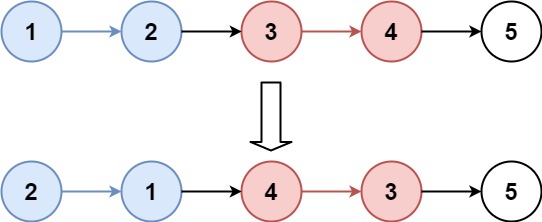
g0001_0100.s0025_reverse_nodes_in_k_group.readme.md Maven / Gradle / Ivy
Go to download
Show more of this group Show more artifacts with this name
Show all versions of leetcode-in-java Show documentation
Show all versions of leetcode-in-java Show documentation
Java-based LeetCode algorithm problem solutions, regularly updated
The newest version!
25\. Reverse Nodes in k-Group
Hard
Given a linked list, reverse the nodes of a linked list _k_ at a time and return its modified list.
_k_ is a positive integer and is less than or equal to the length of the linked list. If the number of nodes is not a multiple of _k_ then left-out nodes, in the end, should remain as it is.
You may not alter the values in the list's nodes, only nodes themselves may be changed.
**Example 1:**

**Input:** head = [1,2,3,4,5], k = 2
**Output:** [2,1,4,3,5]
**Example 2:**

**Input:** head = [1,2,3,4,5], k = 3
**Output:** [3,2,1,4,5]
**Example 3:**
**Input:** head = [1,2,3,4,5], k = 1
**Output:** [1,2,3,4,5]
**Example 4:**
**Input:** head = [1], k = 1
**Output:** [1]
**Constraints:**
* The number of nodes in the list is in the range `sz`.
* `1 <= sz <= 5000`
* `0 <= Node.val <= 1000`
* `1 <= k <= sz`
**Follow-up:** Can you solve the problem in O(1) extra memory space?
To solve the "Reverse Nodes in k-Group" problem in Java with a `Solution` class, we can reverse the nodes in groups of k using a recursive approach. Here are the steps:
1. Define a `Solution` class.
2. Define a method named `reverseKGroup` that takes the head of a linked list and an integer k as input and returns the head of the modified list.
3. Define a helper method named `reverse` that takes the head and tail of a sublist as input and reverses the sublist in place. This method returns the new head of the sublist.
4. Create a dummy ListNode object and set its `next` pointer to the head of the input list. This dummy node will serve as the new head of the modified list.
5. Initialize pointers `prev`, `curr`, `next`, and `tail`. Set `prev` and `tail` to the dummy node, and `curr` to the head of the input list.
6. Iterate through the list:
- Move `curr` k steps forward. If it's not possible (i.e., there are less than k nodes left), break the loop.
- Set `next` to the `next` pointer of `curr`.
- Reverse the sublist from `curr` to `next` using the `reverse` method. Update `prev` and `tail` accordingly.
- Move `prev` and `tail` k steps forward to the last node of the reversed sublist.
- Move `curr` to `next`.
7. Return the `next` pointer of the dummy node, which points to the head of the modified list.
Here's the implementation:
```java
public class Solution {
public ListNode reverseKGroup(ListNode head, int k) {
// Create a dummy node and point its next to the head
ListNode dummy = new ListNode(0);
dummy.next = head;
// Initialize pointers
ListNode prev = dummy, curr = head, next, tail;
// Iterate through the list and reverse in groups of k
while (true) {
// Move curr k steps forward
tail = prev;
for (int i = 0; i < k; i++) {
tail = tail.next;
if (tail == null) return dummy.next; // Less than k nodes left
}
next = tail.next; // Save the next pointer of the sublist
tail.next = null; // Disconnect the sublist from the rest of the list
// Reverse the sublist and update prev and tail pointers
prev.next = reverse(curr, tail);
tail.next = next; // Connect the reversed sublist back to the rest of the list
// Move prev, tail, and curr to the next group
prev = curr;
curr = next;
}
}
// Helper method to reverse a sublist from head to tail
private ListNode reverse(ListNode head, ListNode tail) {
ListNode prev = null, curr = head, next;
while (curr != null) {
next = curr.next;
curr.next = prev;
prev = curr;
curr = next;
if (prev == tail) break;
}
return prev; // Return the new head of the reversed sublist
}
}
```
This implementation provides a solution to the "Reverse Nodes in k-Group" problem in Java without modifying the values in the list's nodes. It recursively reverses the nodes in groups of k.© 2015 - 2024 Weber Informatics LLC | Privacy Policy